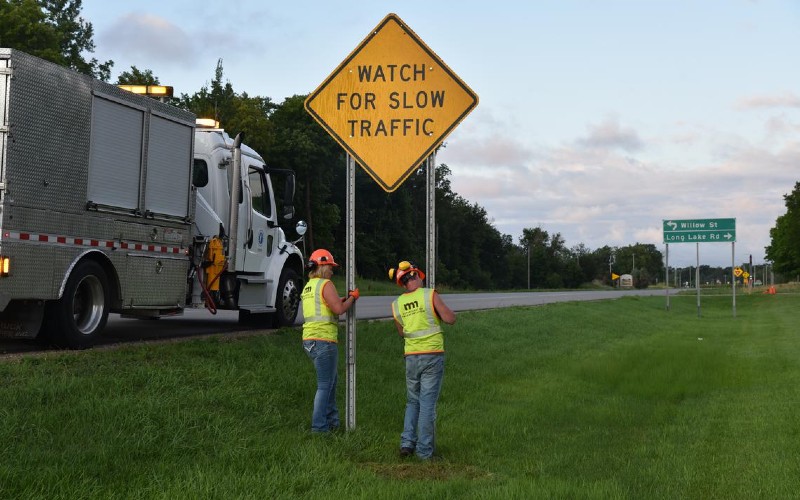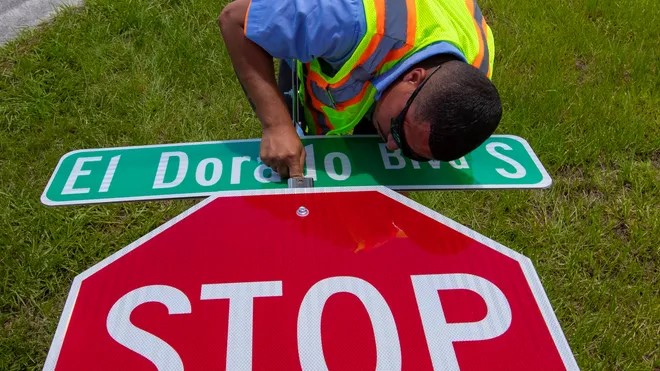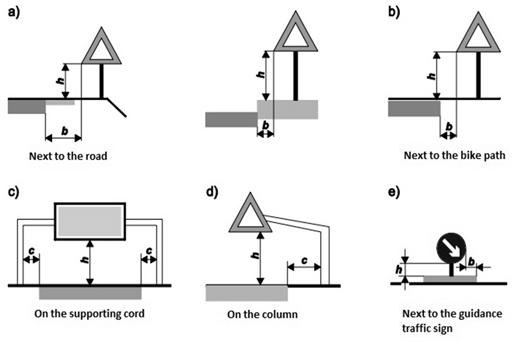If you are a city planner or a road construction company manager, you should know the right method to install traffic signs on highways. Basically, the traffic sign installation process is not only about fixing signs on roads. You have to follow some rules, use the right tools, and also ensure public safety. This is exactly what we will explain to you in this guide.
Legal Requirements & Compliance (MUTCD)
For traffic sign installation, there are also some rules and legal standards that you have to follow. These rules are designed by the Manual on Uniform Traffic Control Devices (MUTCD).
- You should use specific colors and shapes, such as red for stop and yellow for warning.
- You have to install that type of traffic sign that makes the text easy to read.
- The icons and symbol designs at traffic signs must be approved by the MUTCD.
- You should care about the height of the sign from the ground. For example it must be 5 to 7 feet from land.
- If you want to install curves or bump signs then you have to place them with enough distance to warn drivers earlier.
- To avoid legal trouble, you need to choose a traffic sign that is made of durable material (aluminum).
- During the construction of roads and buildings near highways, as a municipal worker & manager it’s your responsibility to install temporary traffic signs at those sites.
11 Simple Steps For Traffic Sign Installation

1. Site Assessment & Planning
First of all, you need to carefully check the location where you want to install traffic signs. For example, you can take a look at the road, traffic flow, and what is around the spot. In this way, you can decide the best and ideal position for your traffic sign. In the residential area, you need to place a speed limit, children crossing,g and no parking signs.
However, you can use regulatory & warning signs at main roads and highways such as: no overtaking, sharp bumps & turns. For other locations like school zones, railway crossings and pedestrian areas, you have to make a plan according to these areas requirements.
2. Tool Preparation
Now, you need to gather all the important tools. It’s important to get everything because when your tools are ready and in good condition, you can work in a fast way.
It also helps you to keep the installation process safe and accurate. Following are some tools which you must have.
- Post-Hole Diggers: To dig holes in the ground where you will place signposts.
- Sign Post: Provide the main support that holds up the traffic sign so everyone can see it clearly.
- Drill: You need a drill to make holes in metal and other materials to fix the sign tightly in place.
- Spanners: Help you tighten nuts and bolts so the sign stays secure and doesn’t move from its position.
- Screwdrivers: To attach parts and screws of the traffic sign properly at a fixed point.
- Post Driver: This tool helps you push the signpost deep into the ground, so that it can’t get damaged.
- Spanners: You need spanners to grip/turn nuts and bolts during sign installation.
- Sign Post Cap: A Small cover placed on top of a traffic sign post. It is used to seal the open end of the post to keep out rainwater, dust, insects, and debris.
3. Selection of Right Sign Type/Material
Well, you have to ensure that the materials of the sign post should suit your location and purposes. But, if you pick the wrong type, you may face issues like: signs may lose color quickly, rust and not be visible enough.
Therefore, you should carefully choose a traffic sign which has durable materials, lasts long and provides you desired safety standards. It is also important that a sign must convey a message to the public which you want to show.
We suggest you buy steel-made traffic signs because they have high-intensity reflective sheets. Also, choose the type according to your particular area requirements.
4. Installation Techniques
Now it’s time to install traffic signs, but you need to select the right installation method. The reason is that different sites and surfaces may need different techniques. Below are the three common installation ways you can consider:
-
Concrete Post Installation
If you have open land or road sides, concrete post installation is an ideal option for you. Basically concrete is used to fill the hole that can strongly grab your traffic signs. This method works well when you want a permanent and stable base.
-
V-Lock System
This system is perfect when you want to remove and replace sign posts. In the V-Lock mechanism you have to fix the V shapes socket into ground. Additionally, you don’t need any type of digging and cement to install the post and sign board.
-
Lock-Socket System
In this method, you need to install a socket in the ground that can hold the post tightly. Then you should lock the sign post in this socket. You can also unlock the post if needed and replace it if it gets damaged.
5. Install the Post
Once you have chosen the installation techniques, you can place the signpost in the ground. The location of the post should not be too close to the road. With the help of a post hole digger, dig the hole at least 2–3 feet deep. Additionally, the hole must be wide enough to hold the post.
Now push the post into the ground by the use of a post driver. Post should stand straight and upright. Now fill the hole with concrete then let it set for 24–48 hours. However if you use a lock socket system then you have to insert the post into the socket and lock it with a screw. You can also use a spanner to tighten bolts / nuts.
6. Mount the Traffic Sign
Next, you need to fix the sign at the correct height and angle. You have to ensure that these signs are easily visible to drivers. To secure a sign with bolts / brackets, you can use equipment like drills, screwdrivers and spanners.
It should be stable and straight. If you don’t mount it properly, these signs may bend, fall and get damaged in wind & rain. Hence, this situation can confuse you and lead to accidents.
7. Position the Traffic sign
The front of the signs must be angled toward the drivers, so that drivers can see them clearly from a far distance. In this way, as a driver, you will have enough time to see and react.
Plus, it should not bend backward and the bottom edge of the sign must be around 1.5 to 2.1 meters above ground. You should always follow the legal standard regulated by MUTCD about height, distance and angle requirements.
8. Add a Sign Post Cap
The addition of a sign post cap helps you to secure your installation for a long time. But, if you want best results you have to choose a sign post cap that perfectly matches the size and shape of your signpost. You can pick square or round shaped post caps which are made from plastic / metal.
Now, fix it on top of the post; it shouldn’t be too loose or too tight. You also need to gently push down the cap into the post. In some cases, you have to secure the cap with screws or lock clips to tighten them.
9. Check for Potential Obstructions
You need to look around and assess if it is anything which blocks your traffic sign view. This helps you confirm that every road user & drivers can easily spot / read the sign without any trouble. For this purpose, you should check it from different angles and distances. Below are some possible obstacles.
- Tree Branches: If you notice that branches are hanging in front of the board, it can block the clarity of the message. So, you should trim or remove them and make the sign visible to everyone.
- Poles or Power Lines: Sometimes, poles & power lines can hide sight of your signs. Therefore, you have to ensure that such obstacles can’t block the sign from any angle.
- Buildings or Fences: Well, a wall or building can also interrupt the visibility of traffic signs. You need to place the sign at that location where drivers can spot it early and easily.
- Parked Vehicles: Your parked vehicles may block the sign, generally in busy areas. In this case, you should install the post at a higher point to keep it visible at all times.
10. Clear Visibility and Durability
If we talk about the position of placement, you should choose the location where everyone can see the traffic sign clearly while driving. The height and angle must be in the right positions.
Plus, the material of the sign should be able to survive in sun (UV protection), storm and tough conditions. If you do all this work in the correct way, your traffic sign will work efficiently 24/7 hours.
11. Maintenance of Traffic Sign
It is important for you to keep your traffic signs in good condition once you install them. Because, if the sign is dirty or gets damaged, they can’t serve their job as you want. Hence you need to check them on a regular basis for their maintenance. Following are some steps you can do.
- You can simply wash or wipe signs to keep them clean and free from dust. This will make them visible for a long time and their quality will remain good.
- If you notice any part of the sign getting damaged such as bolts are lost or broken. You have to replace and fix them immediately.
- Make sure that sign boards are easy to read by drivers in all possible directions. If it doesn’t, you may face accidents, confusion and legal issues too.
- We recommend that you do regular inspections at least every 3 to 6 months if it is a high-traffic zone. However, in rural areas or less traffic roads, 6 to 12 month inspection time is ideal.

Guidelines For Placement of Traffic Signs
As we know, proper instalments make signs visible to all and durable. However, there are still some certain rules which you should follow for advanced safety of drivers and pedestrians as well.

Height, Angle & Distance Rules
You have to decide the height of the traffic sign according to the particular location. You also need to place them at a proper distance from curves, hazards and intersections. Generally, a distance of 100 to 300 feet is ideal based on road type & speed limit.
Reflectivity and Night Visibility
The traffic sign which is manufactured by reflective material will work well in low light conditions & reflect car headlight. So, when you choose that type of sign, you will see drivers can easily spot them clearly at night & in fog.
Replacement of Traffic Sign
Over time, your traffic signs may be damaged by rust and when their material gets old. In such cases, you should replace any sign that is unclear & missing.
Can You Also Install Road Sign Storage Racks For Traffic?
Yes, you can definitely install road sign storage racks if you want to keep extra traffic signs safe & organized. Additionally, it is a smart and common way to manage traffic signs for future use and emergency replacements. Because, you can easily access them whenever you need.
FAQs
When Should I Replace a Sign?
You should replace a sign when it is damaged, rusted, outdated information or hard for you to read. Plus, if the sign is missing or not reflective at night, then you also need a replacement.
Where Can I Buy Supplies to Help Me Install Road signs?
Well, there are lots of options for you to purchase them. For example: you can buy them from traffic safety equipment suppliers, online industrial retailers and hardware stores.
What is the Standard Size of a Street Sign?
The size can be changed based on local regulations, road type and visibility needs. But we can provide you with a general size measurement idea, which is 24 inches wide by 6 to 9 inches high for your street signs.
Final Thoughts
In the end, we hope you are now aware about all the important things related to traffic sign installation. You can see how each step helps you to build safer environments for everyone.
Are you looking for a top manufacturer of traffic signs in China? You can contact JACKWIN professionals today. Our team constructs ISO-certified traffic signs. We have a product range which fulfills all MUTCD requirements as well. You can also get customized signs at affordable prices.


-80x69.png)

